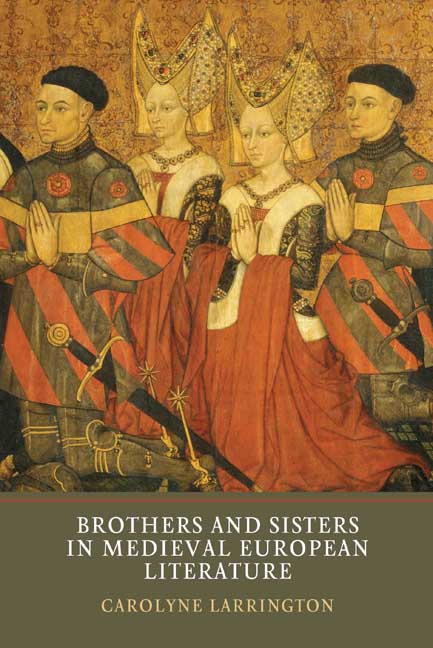Book contents
- Frontmatter
- Dedication
- Contents
- Acknowledgements
- Abbreviations
- Introduction
- 1 The Medieval Sibling in History
- 2 ‘Berr er hverr á bakinu nema sér bróður eigi’: Fraternal Love and Loyalty
- 3 ‘Io v’ho cara quanto sorella si dee avere’: Sisters, and their Brothers
- 4 ‘Næs þæt andæges nið’: Fraternal Hatreds
- 5 ‘Te souviegne de ce que je suis ta seur’: Sisters and Hostility
- 6 ‘The king’s dochter gaes wi child to her brither’: Sibling Incest
- 7 ‘So wil ich dir ce wibe mine swester gebn’: When Siblings Marry
- 8 ‘Trewethes togider that gun plight’: Fictive Siblings
- Conclusion
- Bibliography
- Index
1 - The Medieval Sibling in History
Published online by Cambridge University Press: 08 May 2021
- Frontmatter
- Dedication
- Contents
- Acknowledgements
- Abbreviations
- Introduction
- 1 The Medieval Sibling in History
- 2 ‘Berr er hverr á bakinu nema sér bróður eigi’: Fraternal Love and Loyalty
- 3 ‘Io v’ho cara quanto sorella si dee avere’: Sisters, and their Brothers
- 4 ‘Næs þæt andæges nið’: Fraternal Hatreds
- 5 ‘Te souviegne de ce que je suis ta seur’: Sisters and Hostility
- 6 ‘The king’s dochter gaes wi child to her brither’: Sibling Incest
- 7 ‘So wil ich dir ce wibe mine swester gebn’: When Siblings Marry
- 8 ‘Trewethes togider that gun plight’: Fictive Siblings
- Conclusion
- Bibliography
- Index
Summary
Introduction
It is still too early to write the history of the medieval sibling, a history of the kind that has, in recent years, been written of medieval marriage and of the medieval family. The expanding field of the history of childhood has largely been shaped by an earlier historiography which saw as its primary challenge a correction of the views of Ariès, Stone and deMause. These historians argued that medieval parents did not make a strong emotional investment in their children: a detachment thought to be rooted in the high mortality rates for infants and young children. Attentive analysis of parent–child relations were the primary means of refuting these arguments, and thus vertical relationships came to be privileged, while sibling or lateral relations have been comparatively overlooked. Other medieval historians have examined in close detail the documentary evidence in archives and have pored over marriage contracts and wills to uncover the patterns in dowry and inheritance customs across medieval Europe, again focusing largely on parent–child relationships. Piecing together primary and secondary material from archival evidence, individual microstudies, such as the work of Herlihy and Klapisch-Zuber for late-medieval Tuscany, or the investigations of the Carolingian polyptych evidence for tenth-century France, scholars have now found it possible to write the history of the family in its vertical relationships, and the history of medieval marriage across Europe. The sources for writing histories of lateral relationships exist in the same archives and document collections, and in other sources as yet unexamined, but these have not yet come under sustained scrutiny. Some welcome beginnings have been made; for example, Isabelle Réal's research on Frankish society in the sixth to ninth centuries, and the work of Didier Lett and those French scholars who have followed him in close interrogation of sibling relations through a range of case studies. However, until medieval European archival material has been analysed at the micro level with sibling questions in mind, the larger narrative, qua history, of brothers and sisters will remain occluded.
Yet sibling relations are traceable where legal documents exist, for example when brothers determine their sisters’ marriage arrangements, or when the eldest brother receives homage from his younger brothers for property they hold in fief from him.
- Type
- Chapter
- Information
- Brothers and Sisters in Medieval European Literature , pp. 17 - 45Publisher: Boydell & BrewerPrint publication year: 2015



